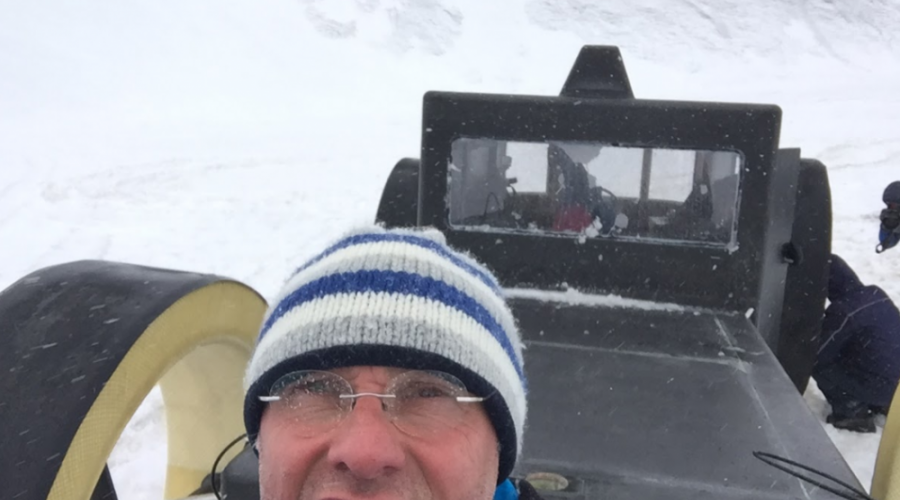My journey with Edwin

I just started an Innovation team and was struggling on how to change the mindset within our company.
Edwin and his team formulated it very well: “A vehicle built from plastic waste, powered by the sun. This is an experiment with clean technology and a model for collaboration”. I was curious about the ‘process to get there’ and my team got involved in Edwin’s journey. I had to promise Edwin I would not give up or quit before he does. We had success and also failed many times. The perseverance of Edwin kept us going and giving up was no option…. Only later I realized that most important success factor was the process he followed; stay optimistic, make small steps, dare to dream and to try. Because of our close partnership I have been able to follow all the dilemmas and hurdles Edwin and Liesbeth faced since the origin of their idea while reflecting on my own journey. What seemed to be an unrealistic in the beginning has now become reality. I learned from them that to overcome the hurdles the most important element to make a change are:
Embrace Discomfort, Dare to Jump, Be actionable and Playful, Dare to Fail
Simple questions or issues can usually be solved and answered by individual persons or small teams in a relatively simple linear process. More complex questions generally require a more structured approach. Multidisciplinary teamwork, planning, project roadmaps, steering teams are needed to structure the process and to control the delivery outcome. This is quite typical approach in companies, however I had the feeling that for my task to develop new ways to transform a company this approach would be insufficient. The most complex and difficult not clearly defined questions require a totally different problem solving method, and my journey with Edwin was one of the experiments to find these new ways.
In 2016, scientists of the Faculty of Textile Science, Kyoto Institute of Technology have made a discovery of the first bacteria that had naturally evolved to eat plastic, at a waste dump in Japan. The new species breaks down the plastic by using two enzymes to hydrolyze PET into its original monomers. It seems that nature is already autonomously making its contribution to a circular economy without any direct human involvement. Is it possible to adapt the same ‘problem solving’ capability to complex issues?
Freely and loosely translated, life on earth evolves around continuous adaptation to external conditions. Key element to make adapt and optimize a population of species is to interact and create as much as diversity as possible, to select the most promising ideas that have the best match, to take that as a next center point of allowing new diversity and so on. In this iterative process the result is evolving / emerging in a group. It is a continuous cycle of trial and error, failure, learning and improving. In the basis it is an unstructured approach, discussing with the end result in mind results in many different views, (partial) solutions. The structured part is the process in which in the different subgroups the best input (best fit solution) is taken as a new starting point for the next iteration round; every day, every watch, always evolving. Progressing without realizing progress is made, like a perpetual mobile. The evolution theory Charles Darwin says about ‘survivors’ : “It is not the strongest of the species that survives, nor the most intelligent, but the one most responsive to change”.
Connected to the Clean2Antarctica mission 21 young talented students and professionals aboard Tallship Morgenster were asked to help Teijin to become more sustainable. On board the same principles were applied and it was an uncomfortable journey indeed in many aspects. Seasickness, tiredness, internal conflicts, deadlines. At first instance this looks like the worst precondition to solve a high complex problem. At second thought it is an essential precondition to be successful. The result gave us remarkable new insights in the transition to a circular economy and the role Teijin can play.
About building the Solar Voyager; In hindsight the technology part of the puzzle was the easiest to solve. We have provided self-heating windows, an innovative tire concept, reinforcement carbon and aramid fabric and strong Technora ropes. All was already there and with modification by our skilled engineers we could make it work in the extreme circumstances of the Antarctic. I learned that the internal process had not been easy. I found new talents in our organization. They were responsive to change and they helped to realize to integrate the technology into the vehicle. We spend many hours in private time to do tests, shaping and forming parts for the Solar Voyager. Thanks to them and their willingness to change their mindset we made it!
In their passionate struggle to reach their crazy goal Edwin and Liesbeth ter Velde have put these principles into practice, and they succeeded. I was happy to be deeply involved in a process that indeed felt like an evolution with remarkable and unexpected outcomes. I will do the same in my role to Innovate Teijin. It’s Cool to be part of it!
Ton de Weijer
Teijin
Steun Zero Waste!
Met jouw hulp kunnen wij mensen en bedrijven inspireren en activeren om plastic niet als afval te zien, maar als waardevolle grondstof.
